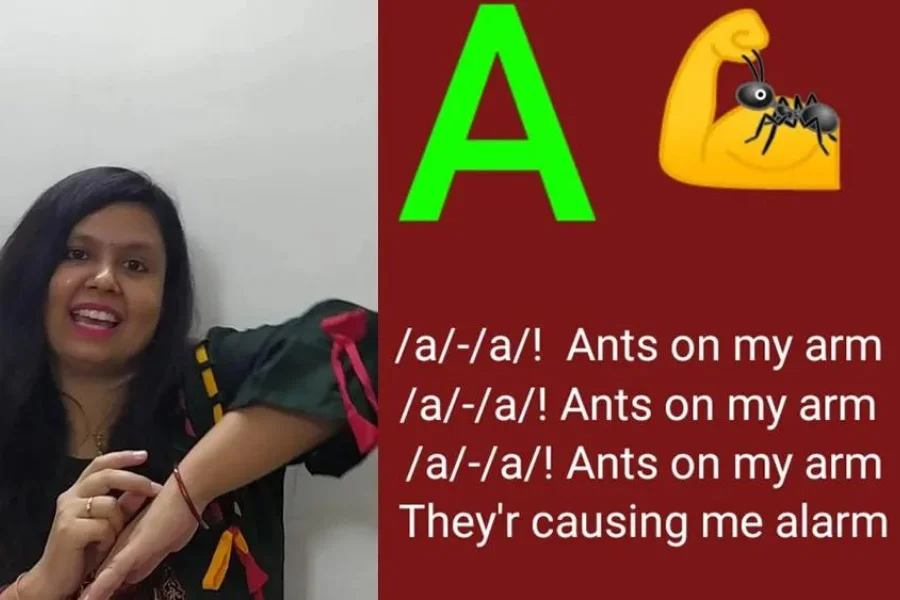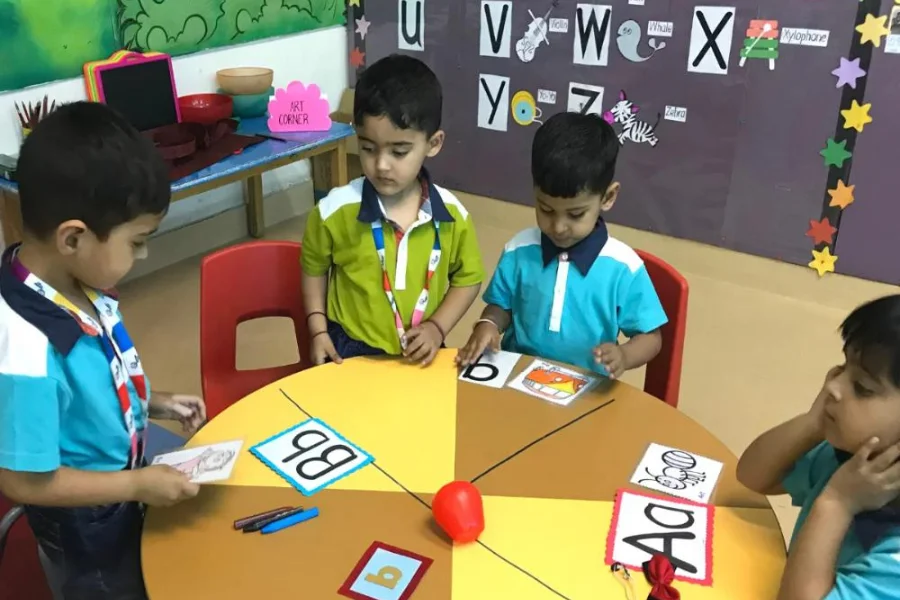
Source: maloointernationalschool
The Phonics Teacher Training Course is crucial for equipping teachers and parents with effective strategies to teach reading, writing and spelling fundamentals. It increases children ability to support early literacy development, enhances a deeper understanding of English language, and ensures that they become confident and independent readers. Phonics Teacher Training Course is crucial for making engaging, child friendly phonics lessons, leading to strong foundation for a child’s lifelong learning journey.
Vidhyanidhi Education Society offers Best Phonics Teacher Training Course which is tailored to equip individuals with all the necessary skills and knowledge to effectively teach phonics and increasing the literacy skills of children at early age. This training is ideal for anyone involved in guiding children through in their early years like parents, teachers, care-givers, professionals from Early Childhood Care and Education field to foster in children love for reading, writing and learning.

Source: oakridge
Benefits Of Learning Phonics
Want to know the Benefits of Learning Phonics, here you go:
- Phonics demystifies the sounds behind English letters.
- There’s a clear distinction between how a letter is named and the sound it produces.
- By mastering these sounds, children find it simpler to create and read words.
- The process also simplifies the task of spelling by segmenting words based on sounds.
- The synergy of reading, writing, and spelling is powered by a strong phonics foundation.
Therefore, investing in quality phonics training is crucial for educators.
Phonics Professional Development for Teachers
Teaching phonics has always been a cornerstone in early childhood education, laying the foundation for children to become proficient readers and writers. However, the methodology and techniques of phonics instruction have evolved significantly over the years. Educators need to stay updated with the latest trends and best practices.
Why is this Phonics Professional Development for Teachers essential?
- Robust Foundation: Phonics is more than just associating sounds with letters. It’s about understanding the intricate patterns in language, allowing children to decode words effectively. Continuous training ensures that educators are well-equipped to set this robust foundation.
- Adapt to Evolving Curriculums: The educational landscape is always changing. By participating in Phonics Professional Development for Teachers, they can be in sync with the newest curriculums and teaching strategies.
- Engaging and Effective Teaching: With the right tools and knowledge, educators can make phonics lessons more engaging. This not only enriches the classroom experience but also aids in better retention and comprehension among students.
- Confidence in Delivery: A teacher who is confident in their subject matter can inspire confidence in their students. Regular training allows teachers to approach phonics instruction with greater assurance.
At Vidhyanidhi Education Society (VES), we understand the importance of equipping our educators with the right tools and knowledge. This blog aims to share insights, experiences, and resources to help teachers excel in their phonics instruction journey.
Whether you’re a seasoned educator or someone just starting, this Phonics Professional Development for Teachers is designed to support your growth and success in the classroom.
Career Opportunities for Phonics Teacher
The intricate tapestry of phonics teaching, particularly when intertwined with the Phonics Professional Development for Teachers at Vidhyanidhi Education Society (VES), unfurls an enticing array of career Career Opportunities for Phonics Teacher.
Delve into the myriad of prospects tailored for the adept phonics educator:
- Innovate a bespoke phonics learning environment at home, yielding substantial financial benefits with lean investments.
- Elevate your tutoring offerings by embedding phonics, giving your students a cutting-edge advantage.
- Parlay your expertise into rewarding engagements with premier pre-schools and primary educational institutions yearning for phonics specialists.
- School educators can harness the power of phonics to diversify their teaching arsenal, creating avenues for accelerated career enhancements.
- Be the guiding star in renowned global teacher training forums, offering the richness of phonics-centered education.
- Join forces with leading educational conglomerates, donning roles as phonics curriculum designers or innovative content curators.
- Phonics Professional Development for Teachers can pave the way to influential positions in esteemed educational centers or creative learning platforms.
- Dedicate your skills to ushering in transformative learning experiences for children with specialized needs as a phonics interventionist.
- Beyond mere professional accolades, phonics mastery equips parents to be the linchpin in their child’s linguistic odyssey, ensuring they thrive.
For any course-related info, dial +919869546913 / +919869866277.
Quickly download the brochure Here.

Source: y2mate
Teaching Phonics Online
In the landscape of online Phonics Professional Development for Teachers, VES stands as a beacon of excellence.
Principal benefits of Teaching Phonics Online at VES include:
- Perpetual enrolment options.
- Course fees that honor value.
- Rapid enrolment steps.
- International course reach.
- The only baseline requirement: is stable internet.
- Systematic course structure.
- A thorough, downloadable study compilation.
- Compilation entails a teacher’s aide, diverse worksheets, eye-catching flashcards, and holistic multimedia inclusions.
- Thought-provoking online Phonics Professional Development for Teachers sessions.
- Expert-led training modules.
- Relaxed evaluation methodologies.
- Certificate sans mode description.
- Hassle-free certificate delivery.
- Certification with a global footprint.
Course Content of Phonics Teacher Course
After extensive market research and analysis of reliable sources, our experts have devised a Course Content of Phonics Teacher Training Course that bridges theoretical knowledge with practical insights.
Here’s what you can expect in your life-changing Phonics Professional Development for Teachers journey at VES:
- Grasping the Core Concept of Phonics
- Journey through the Spectrum of Phonics Programmes
- Evaluating the Differences: Phonics vs. Whole Language Approach
- Delving into the Basics of Letter Sounds and Their Proper Formation
- Understanding the Art and Science of Blending and Segmenting Words
- A Detailed Look at the Dynamics of Consonant Blends
- A Focus on the Intricacies of Digraph Sounds
- Establishing Clear Distinctions: Digraphs vs. Blends
- Tackling and Understanding Challenging or Tricky Words
- Adherence and Understanding of Standard Phonics Guidelines
- A Comprehensive Guide on the Variability of Vowel Sounds and Their Respective Spelling Patterns.
With this Phonics Professional Development for Teachers curriculum, VES aims to offer learners a well-rounded understanding of phonics, ensuring they are equipped with the tools and knowledge to excel in this domain.

Source: istockphoto
Structure Of Phonics Teacher Training Course
With VES, the Structure Of Phonics Teacher Training Course is designed for your comfort and understanding.
- Begin your interaction with us
- Get a glance at our ethos
- Officially join us
- Delight in the learning session
- Assess your skills
- Treasure your certification moment
- Progress in the Phonics field
- A moment of sheer happiness!
Duration Of Phonics Professional Development for Teachers
The Duration Of Phonics Professional Development for Teachers is structured over six days, and attendees will undergo 3-hour training sessions daily, summing up to 18 hours.
Eligibility For Phonics Professional Development for Teachers
Eligibility For Phonics Professional Development for Teachers requires one to have a working knowledge of English.
Phonics Teacher Salary
Factors ranging from the school’s compensation norms, and its geographical setting, to the individual expertise of the teacher, and prevalent market conditions play a part in determining a Phonics Teacher Salary. However, securing a five-figure sum is quite feasible for someone with certified Training in Phonics Professional Development for Teachers.
Phonics Course Fees
When it comes to affordability, VES’s Phonics Courses take the lead. VES’s Phonics Teacher Training Course Fees are priced below market rates, and with a range of discounts and user-friendly payment options, they’re hard to resist.
For any course-related info, dial +919869546913 / +919869866277.
Download Phonics Teacher Training Course Brochure Here.
What are Tricky Words in Phonics?
In the context of phonics and early reading, “Tricky Words” are words that cannot be easily decoded using standard phonetic rules. The spellings of these words do not correspond to the sounds we would expect them to represent, making them challenging for beginners to sound out using phonics.
For instance, when teaching phonics to children, they are taught that the letter ‘s’ corresponds to the /s/ sound (as in “soap”) and the letter ‘a’ corresponds to the /æ/ sound (as in “bat”). However, there are words like “said” where the letter combination ‘ai’ does not make the regular /ai/ sound as in “snail”; it instead makes the /ɛ/ sound, which can confuse new readers. This makes “said” a tricky word because it doesn’t follow the typical phonics patterns that children are initially taught.
Some examples of Tricky Words in Phonics include:
- The
- Was
- Said
- One
- Have
- They
- Some
- Does
Children need to recognize and remember tricky words because they occur frequently in texts. Over time, and with exposure, these words usually become part of a reader’s sight vocabulary, meaning they can be recognized instantly without needing to be sounded out.
Many incorporate the teaching of Tricky Words in Phonics alongside the teaching of phonetic patterns, ensuring that young readers are equipped to handle the idiosyncrasies of English spelling as they encounter them in real texts.

Source: pinterest
What are Word Families in Phonics?
“Word Families in Phonics” refers to groups of words that have a common pattern or feature, specifically a similar ending. This concept helps children recognize and read new words based on their understanding of familiar patterns. Word families are often used in early reading instruction because they tap into kids’ abilities to notice patterns and decode words based on those patterns.
Here are some examples of Word Families in Phonics:
- at family: cat, bat, rat, sat, hat, mat, pat
- ip family: sip, tip, hip, rip, lip, dip, ship
- ug family: hug, bug, rug, mug, tug, plug, snug
- an family: man, can, ran, pan, fan, tan, plan
When children learn one word from a word family, it becomes easier for them to read or decode other words that fit the same pattern. For instance, if a child knows the word “hat” and comes across “bat” in a book, they can use their knowledge of the “-at” sound to help them read the new word.
Additionally, word families can be extended to include more complex word patterns and longer words as children progress in their reading skills:
- ight family: light, night, right, flight, fright, slight
- ake family: cake, bake, snake, flake, shake, mistake
Word Families in Phonics can be a powerful tool in teaching reading and spelling because they emphasize patterns within words, helping children make connections between words that sound similar.
What are Sight Words in Phonics?
Sight Words in Phonics are terms used in reading instruction, but they refer to different approaches and concepts of “Sight words” and “Phonics”.
Let’s clarify both:
Sight Words
Sight words are those that children are motivated to identify immediately, “at first sight,” without sounding them out.
Many sight words don’t follow standard phonetic patterns and are difficult to decode using basic phonics rules. Examples include: the, was, they, said, etc.
The idea is to enable children to read these words fluently without stumbling over them, allowing for smoother, more comprehensive reading.
Lists like Dolch and Fry sight words are popular compilations that many educators use. These lists contain words that frequently appear in children’s texts.
Phonics
Phonics is a method of teaching reading by correlating sounds with symbols (letters) in an alphabetic writing system.
Through phonics, children learn to decode words by sounding them out, or in phonics terms, “blending the sounds.”
For example, with the word “cat,” children would learn to blend the sounds of each letter: /c/ /a/ /t/ to form the word.
In a balanced literacy program, both sight words and phonics are taught. While phonics provides the foundational skills to decode many words, sight words help children read more fluently and understand texts that contain words that don’t adhere strictly to phonetic patterns.
Vidhyanidhi: Where phonics champions are made!
For any course-related info, dial +919869546913 / +919869866277.
Quickly download the brochure Here.
FAQs
How to teach Phonics skills?
Teach Phonics skills by introducing individual sounds, blending, digraphs, & hands-on activities. VES covers these skills in its comprehensive curriculum.
Why are Phonics important?
Phonics are crucial as they provide the foundation for reading, aid in decoding words, and promote comprehension, enabling fluent reading.
What is the Phonetic sound of I?
The Phonetic sound of "I" is /ɪ/ as in "igloo" or "in". Recognizing this sound is key in phonics instruction.



